As an Amazon Associate I earn from qualifying purchases.
Huitlacoche, “corn smut,” is a mushroom that grows on corn, and is amazing cooked with chile, cheese, and onion on a tortilla as a huitlacoche quesadilla.

As far as the star ingredient is concerned, this is one of those, “if you know you know” deals. Revered in Mexico, this fungus is viewed as a virulent pest in the United States. Thankfully, as more people get a chance to eat it, attitudes are changing.
Pronounced “wheet-la-KOH-chay,” which is a Nahuatl (Aztec) word, the mushroom is intimidating to look at. Perverse swelling of corn kernels that turn from gray to black, it’s easy to see how you’d look at it and go, “big nope.”
But looks are deceiving. The flavor is like corn and mushrooms mashed together, which makes sense: Floral, sweet, earthy, savory, if you’re not used to it, huitlacoche is a sort of “edge food” you feel proud of yourself for liking.
All this goes out the window if you’re Mexican, where a huitacoche quesadilla is a simple treat you look forward to when its in season, which can be months long depending on where you are in Mexico.
Buying Huitlacoche
Unless you are a corn farmer, the fungus found your garden corn, or you know someone, chances are you won’t be able to find huitlacoche fresh.
Very occasionally you can find it in farmer’s markets, especially if you live in an area where there are lots of Mexicans, and sometimes you will see it in Latin markets.
More often you’ll be buying huitlacoche frozen, which you can do online. This is more common in the freezer section of Latin markets, but it’s still a find.
Oh, and yes, there is a such a thing as canned huitlacoche. I am not a fan. Sorrynotsorry.

Huitlacoche Quesadilla
OK, so you’ve found some fresh or frozen huitlacoche. Here’s a very common way to make a huitlacoche quesadilla, which is in my experience the most common way to eat it.
Sauté onions, roasted green chiles, herbs and garlic in lard or oil, then add in the huitlacoche. Cook this down into a cohesive mass.
Melt some cheese on a tortilla — corn would be the rule here — then spoon the filling on, fold over the quesadilla and cook until the cheese starts to brown as it oozes out. That’s it.
The only other thing you’d do would be, when serving them, open the huitlacoche quesadilla up and add salsa to taste.
I prefer a fierce salsa de chile de arbol here, but any hot salsa will do.
Huitlacoche Quesadillas
Ingredients
- 3 tablespoons lard or oil
- 1 cup chopped white onion
- 1 pound huitlacoche
- 2 Anaheim, poblano or chilaca chiles, roasted, peeled, seeded and roughly chopped
- 2 cloves garlic, minced
- 1 tablespoon minced epazote or cilantro
- salt
- 1/2 pound mozzarella, Oaxaca or other melty cheese, shredded
- 12 corn tortillas
Instructions
- Heat the lard in a large pan over medium-high heat. Sauté the onion for a few minutes, then add the huitlacoche and roasted, chopped green chiles. Sauté this for a good 5 to 7 minutes, then add the garlic. Drop the heat to a simmer and let it cook gently.
- At this point, heat up all your corn tortillas on a flattop, griddle or comal, keeping them warm in a tortillero or in a cloth.
- Mix the epazote or cilantro into the huitlacoche and add salt to taste.
- Put some shredded cheese in a tortilla, fold it over and heat it on the comal until the cheese starts to melt. Open them, add some of the huitlacoche mixture, then re-close and flatten them on the comal. When the cheese starts to brown a little, flip and cook the other side. Repeat with the other quesadillas.
- If you want, you can set a rack over a baking sheet and put that in the oven. Set the oven to "warm" to keep them all hot while you make the rest.
Notes
Nutrition
Nutrition information is automatically calculated, so should only be used as an approximation.

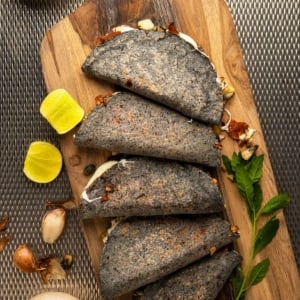
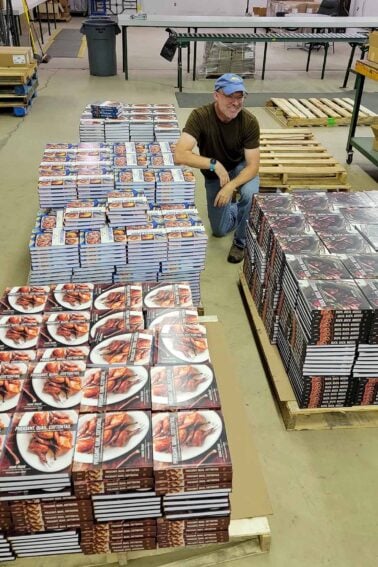
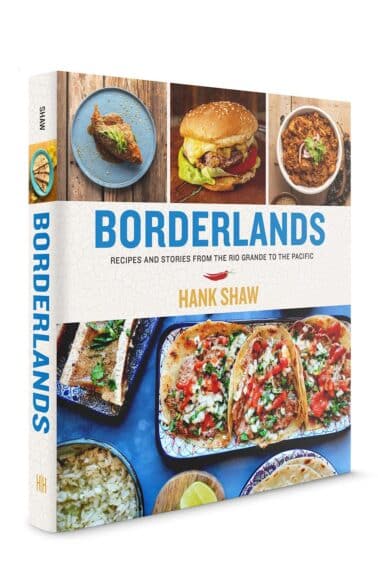
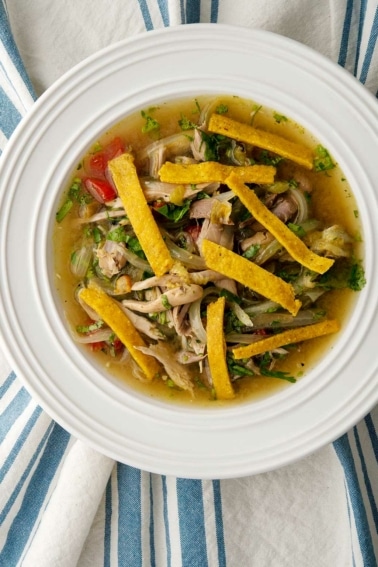
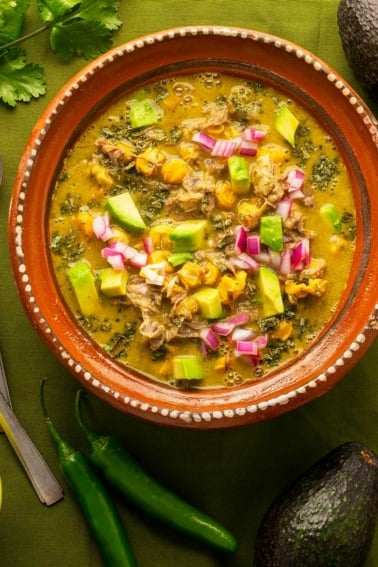
Mr. Shaw: what, please, is the hemisected yellow vegetable/fruit entity seen in the very enticing photograph accompanying this recipe?
Thank you!
Winston: You mean the cut lime? Or the epazote herb?
The cut yellow structure on the left (not the color/hue of any lime I’ve ever seen…an artifact of color-shifted posting, perhaps, or might it be pickled?), not the sage-looking [epizote] herb on the right. It’s visually appealing, but IS it a lime?? (Thank you for your response, regardless!) If this recipe, once I’ve made it, performs as others of yours that I’ve made, it will be exceptional!
Winston: yes, it’s a lime. A ripe one. They turn yellow when ripe.
Huitlacoche or Cuitlacoche is great like this or with some corn grains like succotash, and if you make it creamy with dairy or a bechamel-based sauce, it is great on crepes. In Mexico City it is the most common ingredient along with squash flower for quesadillas, with or whitout cheese. You better don´t try and tell them that would be just a taco if you know what´s good for you.
Ricardo: JAJAJAJAJA! las quesadillas llevan queso, compa! 🙂
On the menu list for September!
Thanks Hank!
Tad
Are you still working on that mexican cookbook? I sure hope so!
Dom: Yes, I am.
I have repeatedly successfully grown Huitlacoche using fresh AND frozen stocks of Huitlacoche. I whizzed some up in 90 percent water, 10 percent milk and injected the presumably spore rich solution into young rapidly growing backyard corn. Great results but possibly even better if done with various heirloom Oaxacan corn or perhaps Peruvian giant purple corn. Under the right high moisture summer conditions, it will infect your entire corn harvest so be prepared for a lot of Huitlacoche if you have a large corn planting. And it can come back next year if you continue to plant corn in the same soil.
This looks amazing and I’ll be on the hunt for in our local markets. My wife introduced me huitlacoche in Mexico and I’ve been a fan ever since. Can’t wait to actually make it.
Growing up next to corn fields of the Midwest, I became very allergic (immunologists tested) to the corn smut that grew on some of the ears. Some need to be careful about eating this fungus.
This goes without saying but a reminder is helpful.
Allergy tests can reveal various fungi that should be avoided—actually, there are many foods to which one could be allergic, however, both false positives and negatives can occur. The best “test” is your own experience, as you’ve stated.
I always heard that corn smut produced small amounts of LSD-Haha. I know this is not a factore for this recipe but I thought it was an interesting thing to say. I would have never thought you could eat corn smut- like wow. I grow corn and live where corn is grown everywhere- so I’m sure I’m probabaly going to try this. Thanks Hank for your very unique recipes.
Walt: Not corn smut, ergot, a fungus that can appear on wheat or rye. That’s the one with weird, psychedelic powers.
Thanks Hank; I stand corrected. Now I know. I knew it was some kind of fungus growing on staple grops grown in America.
Heading for Oaxaca in October. Hope to score some of these bad boys! Thanks for the phonetic spelling.